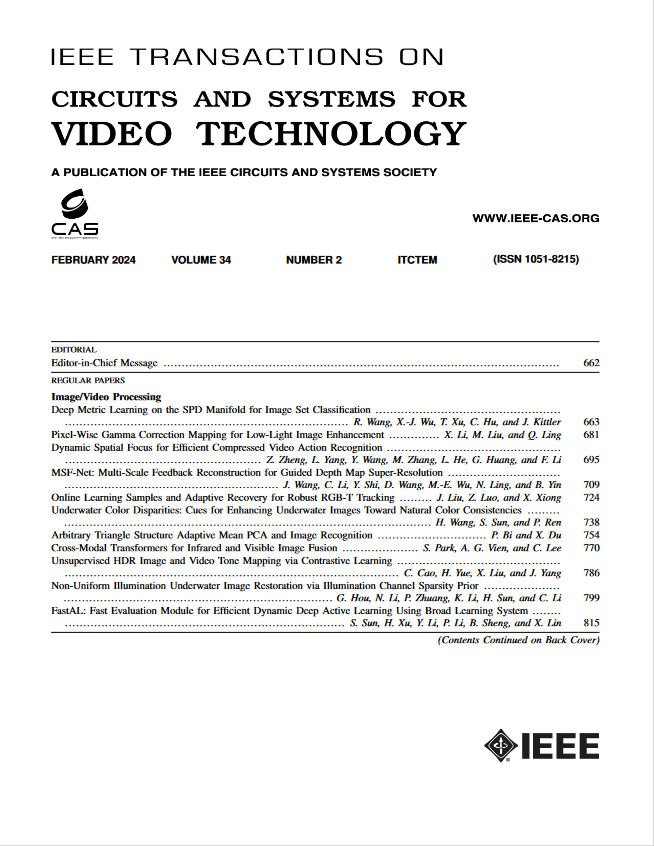基于空间掩模的带噪声标签视频目标分割自适应鲁棒训练
IF 8.3
1区 工程技术
Q1 ENGINEERING, ELECTRICAL & ELECTRONIC
IEEE Transactions on Circuits and Systems for Video Technology
Pub Date : 2025-01-06
DOI:10.1109/TCSVT.2025.3525629
引用次数: 0
摘要
视频对象分割(VOS)的最新进展突出了其在各种应用中的潜力。半监督VOS的目的是基于初始帧的注释对视频帧中的目标对象进行分割。收集大规模视频分割数据集具有挑战性,可能会产生噪声标签。然而,它被忽视了,大部分的研究工作都是通过假设训练数据集是干净的来训练VOS模型。在本研究中,我们首先探索了训练数据集中噪声标签下VOS模型的效果。为了研究噪声标注的影响,我们在DAVIS 2017和YouTubeVOS数据集上模拟了噪声标注。实验表明,传统的训练策略容易受到噪声标注的影响。为了解决这个问题,我们提出了一种新的噪声鲁棒训练方法,称为SMART(基于空间掩模的自适应鲁棒训练),该方法旨在有效地训练存在噪声注释的模型。该方法采用了两个关键策略。首先,该模型通过清晰的基于知识的预测和注释来关注公共空间区域。其次,根据自适应平衡损失的可靠性对模型进行训练;对比实验证明了我们的方法在不同噪声程度下优于其他噪声处理方法的有效性。本文章由计算机程序翻译,如有差异,请以英文原文为准。
Spatial Mask-Based Adaptive Robust Training for Video Object Segmentation With Noisy Labels
Recent advances in video object segmentation (VOS) highlight its potential across various applications. Semi-supervised VOS aims to segment target objects in video frames based on annotations from the initial frame. Collecting a large-scale video segmentation dataset is challenging, which could induce noisy labels. However, it has been overlooked and most of the research efforts have been devoted to training VOS models by assuming the training dataset is clean. In this study, we first explore the effect of VOS models under noisy labels in the training dataset. To investigate the effect of noisy labels, we simulate the noisy annotations on DAVIS 2017 and YouTubeVOS datasets. Experiments show that the traditional training strategy is vulnerable to noisy annotations. To address this issue, we propose a novel noise-robust training method, named SMART (Spatial Mask-based Adaptive Robust Training), which is designed to train models effectively in the presence of noisy annotations. The proposed method employs two key strategies. Firstly, the model focuses on the common spatial areas from clean knowledge-based predictions and annotations. Secondly, the model is trained with adaptive balancing losses based on their reliability. Comparative experiments have demonstrated the effectiveness of our approach by outperforming other noise handling methods over various noise degrees.
求助全文
通过发布文献求助,成功后即可免费获取论文全文。
去求助
来源期刊
CiteScore
13.80
自引率
27.40%
发文量
660
审稿时长
5 months
期刊介绍:
The IEEE Transactions on Circuits and Systems for Video Technology (TCSVT) is dedicated to covering all aspects of video technologies from a circuits and systems perspective. We encourage submissions of general, theoretical, and application-oriented papers related to image and video acquisition, representation, presentation, and display. Additionally, we welcome contributions in areas such as processing, filtering, and transforms; analysis and synthesis; learning and understanding; compression, transmission, communication, and networking; as well as storage, retrieval, indexing, and search. Furthermore, papers focusing on hardware and software design and implementation are highly valued. Join us in advancing the field of video technology through innovative research and insights.

 求助内容:
求助内容: 应助结果提醒方式:
应助结果提醒方式:


